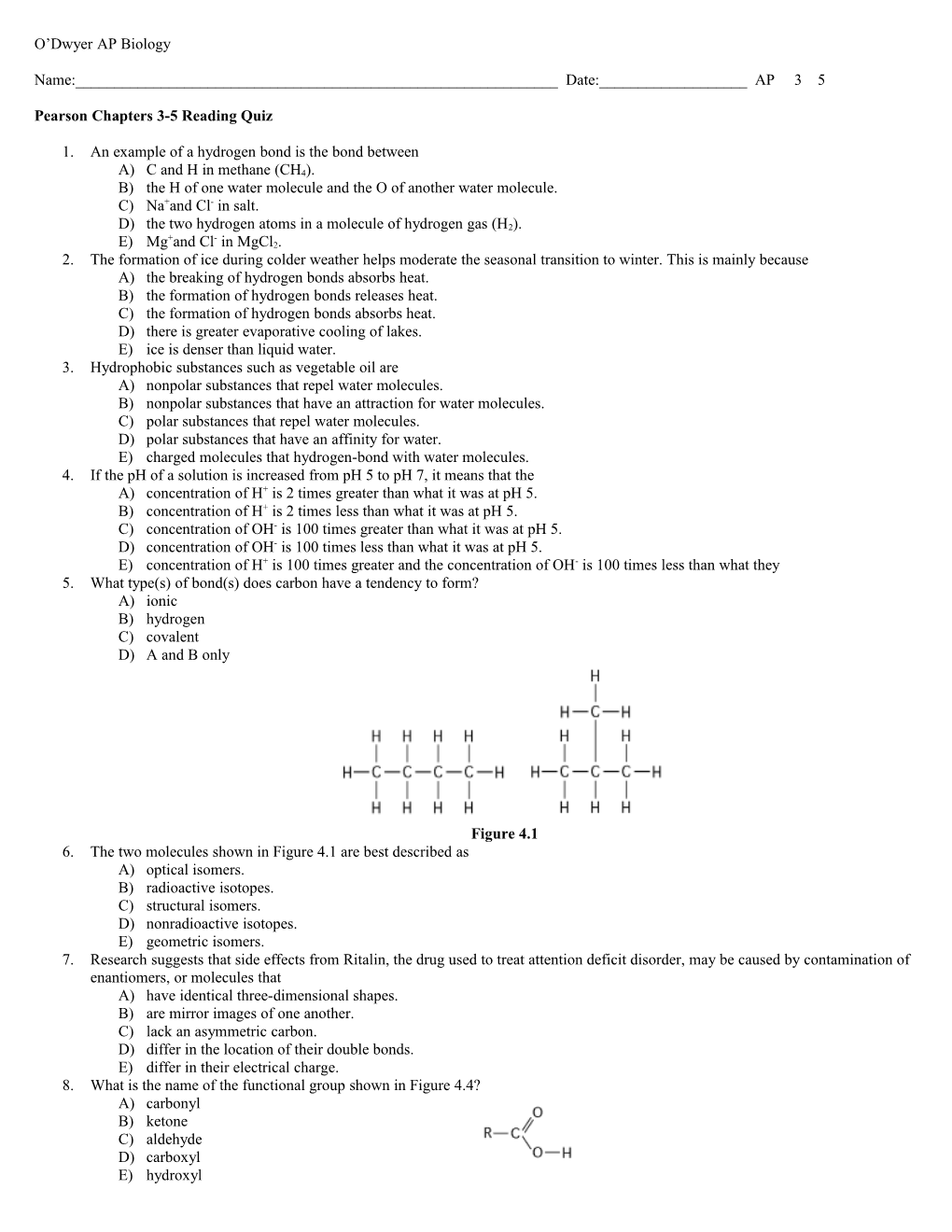O’Dwyer AP Biology
Name:______Date:______AP 3 5
Pearson Chapters 3-5 Reading Quiz
- An example of a hydrogen bond is the bond between
A)C and H in methane (CH4).
B)the H of one water molecule and the O of another water molecule.
C)Na+andCl- in salt.
D)the two hydrogen atoms in a molecule of hydrogen gas (H2).
E)Mg+andCl- in MgCl2.
- The formation of ice during colder weather helps moderate the seasonal transition to winter. This is mainly because
A)the breaking of hydrogen bonds absorbs heat.
B)the formation of hydrogen bonds releases heat.
C)the formation of hydrogen bonds absorbs heat.
D)there is greater evaporative cooling of lakes.
E)ice is denser than liquid water.
- Hydrophobic substances such as vegetable oil are
A)nonpolar substances that repel water molecules.
B)nonpolar substances that have an attraction for water molecules.
C)polar substances that repel water molecules.
D)polar substances that have an affinity for water.
E)charged molecules that hydrogen-bond with water molecules.
- If the pH of a solution is increased from pH 5 to pH 7, it means that the
A)concentration of H+ is 2 times greater than what it was at pH 5.
B)concentration of H+ is 2 times less than what it was at pH 5.
C)concentration of OH- is 100 times greater than what it was at pH 5.
D)concentration of OH- is 100 times less than what it was at pH 5.
E)concentration of H+ is 100 times greater and the concentration of OH- is 100 times less than what they
- What type(s) of bond(s) does carbon have a tendency to form?
A)ionic
B)hydrogen
C)covalent
D)A and B only
Figure 4.1
- The two molecules shown in Figure 4.1 are best described as
A)optical isomers.
B)radioactive isotopes.
C)structural isomers.
D)nonradioactive isotopes.
E)geometric isomers.
- Research suggests that side effects from Ritalin, the drug used to treat attention deficit disorder, may be caused by contamination of enantiomers, or molecules that
A)have identical three-dimensional shapes.
B)are mirror images of one another.
C)lack an asymmetric carbon.
D)differ in the location of their double bonds.
E)differ in their electrical charge.
- What is the name of the functional group shown in Figure 4.4?
A)carbonyl
B)ketone
C)aldehyde
D)carboxyl
E)hydroxyl
Figure 4.4
- Which functional groups can act as acids?
A)amine and sulfhydryl
B)carbonyl and carboxyl
C)carboxyl and phosphate
D)hydroxyl and aldehyde
E)ketone and amino
- Which of the following is not one of the four major groups of macromolecules found in living organisms?
A)glucose
B)carbohydrates
C)lipids
D)proteins
E)nucleic acids
- Which of the following best summarizes the relationship between dehydration reactions and hydrolysis?
A)Dehydration reactions assemble polymers, and hydrolysis breaks down polymers.
B)Hydrolysis only occurs in the urinary system, and dehydration reactions only occur in the digestive tract.
C)Dehydration reactions can occur only after hydrolysis.
D)Hydrolysis creates monomers, and dehydration reactions break down polymers.
E)A and C are correct.
- The α helix and the β pleated sheet are both common polypeptide forms found in which level of protein structure?
A)primary
B)secondary
C)tertiary
D)quaternary
E)all of the above
- Which of the following best describes the flow of information in eukaryotic cells?
A)DNA → RNA → proteins
B)RNA → proteins → DNA
C)proteins → DNA → RNA
D)RNA → DNA → proteins
E)DNA → proteins → RNA
- All of the following nitrogenous bases are found in DNA except
A)thymine.
B)adenine.
C)uracil.
D)guanine.
E)cytosine.
- On a separate sheet of paper, please respond to the following prompt: “The properties of water that make it useful for life are…”
